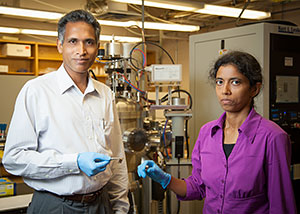Physics’ Varghese and Paulose on 2014 Highly Cited Researchers List
Recognized in the Materials Science Category
 Oomman Varghese, associate professor of physics, and Maggie Paulose, a research scientist
in physics, appear on Thomson Reuters’ Highly Cited Researchers 2014 list in the category
of materials science. Thomson Reuters also included them in the category of “World’s
Most Influential Scientific Minds 2014.” They are the only University of Houston scientists
included on these lists.
Oomman Varghese, associate professor of physics, and Maggie Paulose, a research scientist
in physics, appear on Thomson Reuters’ Highly Cited Researchers 2014 list in the category
of materials science. Thomson Reuters also included them in the category of “World’s
Most Influential Scientific Minds 2014.” They are the only University of Houston scientists
included on these lists.
Highly Cited Researchers 2014 identifies 3,215 researchers who in the last decade have written the greatest number of reports officially designated by Essential Science Indicators as Highly Cited Papers. These papers rank among the top 1 percent most cited for their subject field and year of publication.
Researchers representing 21 fields of science and social sciences appear on the list. Within the area of materials science, 147 researchers worldwide are listed.
As stated on the Highly Cited Researchers website, Thomson Reuters sought to identify influential researchers field-by-field. They focused on contemporary research achievements, looking only at articles and reviews in science and social sciences journals indexed in the Web of Science Core Collection between 2002 and 2012.
Since the list focuses on a fixed time period rather than total citations over many years, the Highly Cited Researchers list recognizes early and mid-career researchers as well as senior researchers.
 “The Varghese group’s interest is in technologies that are of direct relevance to
the environment and society,” said Gemunu Gunaratne, physics department chair. “They
attempt to understand the fundamental science behind nanomaterials (a thickness less
than one-thousandth of a sheet of paper) with the goal of developing useful and efficient
devices. Their inclusion on the Highly Cited Researchers list is recognition of the
relevancy of their work.”
“The Varghese group’s interest is in technologies that are of direct relevance to
the environment and society,” said Gemunu Gunaratne, physics department chair. “They
attempt to understand the fundamental science behind nanomaterials (a thickness less
than one-thousandth of a sheet of paper) with the goal of developing useful and efficient
devices. Their inclusion on the Highly Cited Researchers list is recognition of the
relevancy of their work.”
Nanomaterials are expected to be critical for a broad range of future applications including solar cells, solar fuel generators and environmental sensors, which are the focus areas of the Varghese group. Paulose collaborates with the Varghese Group.
“Our work attempts to solve the many scientific and technical issues with nanostructures of environmentally benign and plentiful materials such as titanium dioxide,” Varghese said. “This is necessary for the successful commercial-scale implementation of the technologies.”
The Varghese group’s work on solar fuels focuses on technologies to convert sunlight and generate fuels with no carbon footprint (e.g., hydrogen via water splitting) or on processes that enable carbon dioxide recycling (e.g., generation of natural gas and other hydrocarbon fuels from carbon dioxide using sunlight).
“Both these approaches are aimed at preventing the carbon dioxide accumulation in the atmosphere that is linked to climate change around the world,” Varghese said.
With their research on environmental sensors, they intend to develop low-cost detectors for use in portable electronics to recognize gases/vapors that affect human health and the environment (e.g., give warning about toxic gas leaks or other polluting environments) and for use in medical applications to help non-invasively diagnose and monitor diseases such as early-stage cancers.
The complete, searchable list of Highly Cited Researchers is available on the Highly Cited Researchers website.
- Kathy Major, College of Natural Sciences and Mathematics